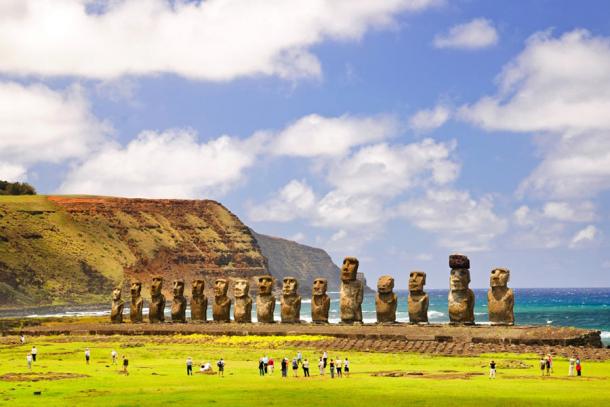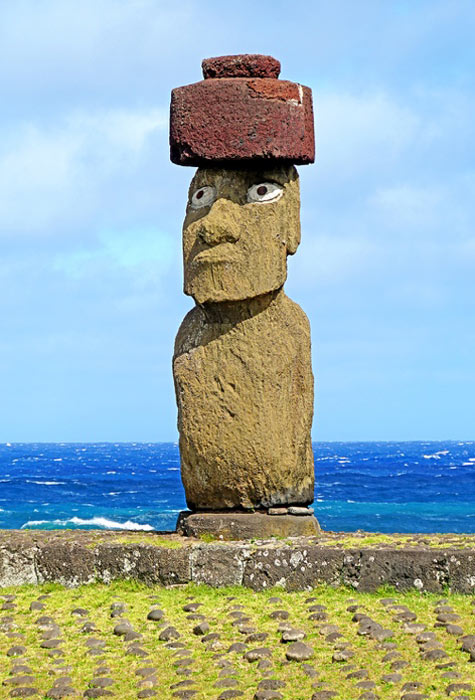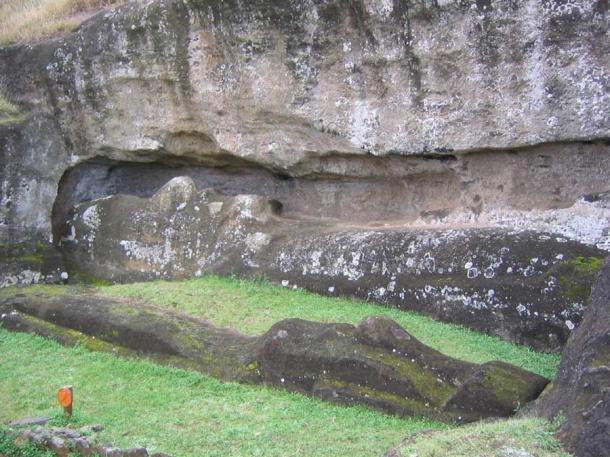
Easter Island and the Mysteries of the Moai
Easter Island, also known as Rapa Nui, is a remote Chilean island a few thousand kilometers west of South America in the Pacific Ocean. Described as an archaeological Disneyland, the island has entered popular imagination thanks to the existence of 887 giant monolithic statues named moai which have puzzled academics since they were first spotted by European explorers.
In fact, the mysteries surrounding Easter Island and its unique culture has ignited the interest of scientists, archaeologists and now tourists, about 100,000 a year according to The New York Times. Due to its giant and monumental architecture, Rapa Nui National Park, which covers over 40% of the island, was designated a UNESCO World Heritage Site in 1994.
- Hidden Rapa Nui: Easter Island’s Cults, Cannibals, and Cultural Connections
- Easter Island’s Moai Enigma Finally Solved?
Easter Island is small, isolated and windswept, offering conditions which make survival difficult. Covering an area of just 163.6 km2 (63.1 mi2), it’s located in the vast Pacific Ocean 3,512 km (2,182 mi) from the South American coast, and 1,900 km (1,200 mi) from Pitcairn Island. When explorers encountered the giant moai statues, which are stunning examples of human achievement by any standard, it led to questions as to how and why they had been created.

The restored Ahu Tongariki, the larges ahu on Easter island with its fifteen restored moai. (Amy Nichole Harris / Adobe Stock)
The Giant Moai Statues of Easter Island
The archaeologist Jo Anne Van Tilburg studied the moai of Easter Island for many years, creating an inventory of all the 887 monolithic stone statues found on the island. Of these 32% (288 statues) were transported to ahu locations, which were the platforms where they were erected. 397 were found in the Rano Raraku volcanic quarry production area, while 92 were discovered between the two, as if their transportation had been abandoned en route.
It’s quite difficult to overplay the mind-boggling impact of these gigantic statues which range from between 1.13 m (3.7 ft) in height to a whopping 21.6 meters (71.93 ft) high. This moai statue is known as El Gigante, was found in the Rano Raraku Quarry and weighs an estimated 145 to 165 metric tons (160 to 182 tons).

Ahu Ko Te Riku, in the Tahai complex, is the only ahu where visitors can see a complete 5.1 meter (16.7 ft) moai. It includes a replica red pukao hat and is the only moai with eyes, made of white coral and obsidian pupils and included in 1990. Archaeologists discovered that the moai originally had eyes in 1979. (Dennis Jarvis / CC BY-SA 2.0)
Meanwhile, the largest upright moai, known as Paro, stands at 9.9 meters (32.63 ft). With an estimated weight of about 74.39 metric tons (82 tons), its understandable that so many people have attempted to figure out how on earth the native Rapa Nui moved the statues from the quarry to their final destinations dotted around the island. The majority of the moai face away from the oceans, as if they are watching over the native Rapa Nui people.
The moai statues themselves are depictions of humanoid faces and their bodies made out of volcanic rock, with a large body and a pukao hat made of red scoria. Most of the Easter Island moai were made out of one enormous and easy-to-carve volcanic tuff sourced at the Rano Raraku quarry, a fascinating destination particularly due to the many statues which were left behind providing much needed clues as to how the statues were made. This kind of factual evidence is the bane of those who somehow believe that the Easter Island heads were created by aliens!

At the Rano Raraku quarry there is evidence to show that the Easter Island moai were carved in situ out of the cliff, separated from the rock face and then transported down to their ultimate locations. (Phil Whitehouse / CC BY 2.0)
Who Created the Moai Statues and Why?
The obvious question is who built these huge statues on such a remote island and why were they placed there? Most archaeologists believe Easter Island was inhabited by Polynesians some time between 300 and 1200 AD, with more recent studies favoring a later settlement date.
The oral history of the Rapa Nui claims the island was first settled by a two-canoe expedition led by chief Hotu Matu ’ a, originally from Marae Renga. Meanwhile, DNA analysis points to the first settlers being of Polynesian origins, though there is academic debate on this point. Nevertheless, some experts argue that settlers may have arrived from South America due to agricultural evidence of the sweet potato on the island which was a staple crop in Polynesia.
The Easter Island moai statues are believed to represent deified ancestors. “Most scholars suspect that the moai were created to honor ancestors, chiefs, or other important personages,” explained National Geographic. “However, no written and little oral history exists on the island, so it’s impossible to be certain.”

Excavation of one of the moai statues on Easter Island, showing petroglyphs visible on the back of the giant statue. (Easter Island Statue Project)
In 2012, the internet suddenly exploded with claims that the “Easter Island heads also have bodies,” to use the words of The Daily Mail. Images started swamping the World Wide Web showing that the statues actually have a full body deep underground with strange ancient petroglyphs carved onto them.
In fact, although tourists often believe that there are only head statues on the island, archaeologists have known that there are bodies hidden underground ever since excavations began in 1914, explained Jo Anne Van Tilburg, director of the Easter Island Statue Project (EISP), in LiveScience. In 2010 the EISP began excavations to document the complex carvings on the moai bodies which have been protected from weathering due to being underground.
These excavations also revealed invaluable information about how the statues were moved to their current locations. This is an aspect which has preoccupied experts for decades, with theories for this engineering feat including the use of sleds, rope, rocking motions, wooden rollers, and even aliens!

Painting by William Hodges, circa 1775 to 1776, showing a view of the monuments of Easter Island. (Public domain)
Are We Asking the Wrong Questions? The Collapse of Easter Island
Although the lack of trees on Easter Island is striking, archaeologists have concluded that it was once covered in trees. When Europeans reached the islands they commented on its arid nature. On spotting the moai, they hypothesized that the island was once home to a large population able to transport such enormous statues, of which few remained by the 1700s.
In his book Collapse: How Societies Choose to Fail or Succeed, Jared Diamond used Easter Island as a poster child of what he termed “ecocide”, thus blaming the natives for their self-inflicted demise. He even suggested that this “moai madness” could be partly to blame for deforestation and the extinction of land birds, and over exploitation of the land, due to their excessive use of trees as rollers to move the statues to their final locations.
Nevertheless, this narrative was contradicted by Terry Hunt and Carl Lipo in their book entitled The Statues that Walked. In their quest for evidence, they argued that Easter Island is actually a survival success story, whereby the ancient Rapa Nui managed to survive on an inhospitable island. In fact, they conducted research on the moai and appear to proove that the statues literally “walked” to their eventual locations, as described in Rapa Nui folklore. Their reenactment which was filmed for a PBS/NOVA documentary proved that the statues could be moved using rope, rocking motion, group effort and patience.
We may never really know what happened on Easter Island. What is for sure is that the ancestor cult which created the moai was replaced by the Birdman Cult around 1540. According to this belief system, the living were able to contact their ancestors through humans chosen through competition rather than through the moai statues. Katherine Routledge argued that the cult survived until the Rapa Nui converted to Christianity by 1868.

Illustration conducted during a French expedition to Easter Island in 1786, entitled “Population of Easter Island and Moai statues during the visit of the La Pérouse expedition in 1786.” (Public domain)
The “Discovery” of Easter Island and the Rapa Nui Struggle for their Rights
Some experts believe that the island was originally called Te Pito O Te Henua, which means “Navel of the World”. It was only named Easter Island, or rather Paasch-Eyland, when the Dutch explorer Jacob Roggeveen “rediscovered” it on Easter Sunday, 5 April 1722, and the name stuck. When Roggeveen arrived he recorded a desolate landscape and a population of just 3,000. Their heightened curiosity unfortunately led to an incident which reduced the population further when Roggeveen ordered his men to fire into the crowd.
In 1770 Easter Island was visited by two Spanish ships who recorded witnessing the enigmatic stone statues looming over the landscape. They were followed in 1774 by the British Captain James Cook who noted that some of the statues had been toppled over and that their purpose was to commemorate former high chiefs. In 1786, a French expedition created maps of the island and illustrations of their time there.
The history of Easter Island has been fraught with the brutal treatment of the native Rapa Nui people, which Hunt and Lipo dubbed a genocide. European explorers brought with them diseases such as small pox and tuberculosis which impacted the population. Then from the 1860s onwards, Peruvian slave traders started raiding the island, ultimately capturing about 1,500 people for their barbaric trade. Amongst these were the chief, his heir and the few Rapa Nui who could read and write their traditional rongorongo script, which led to a huge amount of cultural knowledge being lost for all time. Experts have still not managed to crack the code of this ancient script.
- Photos Reveal Giant Easter Island Moai Statues are Covered in Mysterious Symbols
- New Study Asserts that Easter Island Was Not Destroyed by Warfare
By 1877 there were just 111 Rapa Nui inhabitants left on Easter Island and in 1888 Chile annexed the island. Much of the land was privatized for sheep farming, while other at other moments it was managed by the Chilean Navy. Nevertheless, since 2010 the indigenous Rapa Nui have begun a coordinated effort to fight for their rights. Based on the claim that their land was taken illegally, they are demanding Chile recognize the Agreement of Wills signed in 1888 which accepted their right to collective ownership of the land.
2017 saw an important first step for the native Rapa Nui in that they were finally given management of the Rapa Nui National Park. They have also been working to ensure the repatriation of moai statues, such as a 2.5 meter (8.2 ft) basalt moai statue which was gifted to Queen Victoria in 1869 and now resides in the British Museum, using the argument that the moai “are living incarnations of deceased relatives,” reported Smithsonian Magazine in 2018.
Top image: Easter Island. Source: Aliaksei / Adobe Stock
By Cecilia Bogaard
References
Bartlett, J. 16 November 2018. “‘Moai are family': Easter Island people to head to London to request statue back” in The Guardian. Available at: https://www.theguardian.com/world/2018/nov/16/maoi-easter-island-statue-british-museum-talks-return
Dangerfield, W. 31 March 2007. “The Mystery of Easter Island” in Smithsonian Magazine. Available at: https://www.smithsonianmag.com/travel/the-mystery-of-easter-island-151285298/
Diamond, J. 2004. Collapse: How Societies Choose to Fail or Succeed. Penguin Books Ltd.
Hirst, K. K. 24 November 2019. “How the Moai of Easter Island Were Made and Moved” in ThoughtCo. Available at: https://www.thoughtco.com/making-the-moai-of-easter-island-170750
Hunt, T. & Lipo, C. 2011. The Statues that Walked: Unraveling the Mystery of Easter Island. Free Press.
Long Now Foundation. 23 May 2020. “The Statues Walked -- What Really Happened on Easter Island | Terry Hunt and Carl Lipo” in YouTube. Available at: https://www.youtube.com/watch?v=xGxE3MCchCA
No name. 24 June 2012. “Easter Island Mystery Solved? New Theory Says Giant Statues Rocked” in National Geographic. Available at: https://www.nationalgeographic.com/culture/article/120622-easter-island-statues-moved-hunt-lipo-science-rocked
No name. 13 June 2018. “Discover the Mysteries of Easter Island” in National Geographic. Available at: https://www.nationalgeographic.com/travel/world-heritage/article/easter-island
Solly, Meilan. 21 November 2018. “Rapa Nui Representatives Visit British Museum to Discuss Repatriation of Moai Statue” in Smithsonian Magazine. Available at: https://www.smithsonianmag.com/smart-news/british-museum-hosts-rapa-nui-representatives-discuss-repatriation-easter-island-statue-180970878/
Van Tilburg, J. A. 2003. Among Stone Giants: The Life of Katherine Routledge and Her Remarkable Expedition to Easter Island.
Wolchover, N. 25 May 2012. “Do the Easter Island Heads Really Have Bodies?” in LiveScience. Available at: https://www.livescience.com/20580-easter-island-heads-bodies.html
Wrenn, E. 25 May 2012. “Hidden treat: The Easter Island heads also have BODIES” in The Daily Mail. Available at: https://www.dailymail.co.uk/sciencetech/article-2149846/Hidden-treat-The-Easter-Island-heads-BODIES.html
Various. 2010. South Pacific Tales - Legends and Myths from Tonga, Samoa, Papua New Guinea, Easter Island. Read Books.
















Comments
“Nevertheless, some experts argue that settlers may have arrived from South America due to agricultural evidence of the sweet potato on the island which was a staple crop in Polynesia.”
This doesn’t make any sense. South America is not in Polynesia.
Anyway, this marshalling of labour to make statues looks like a make-work program, typical of ancient (and ‘modern’!) societies, to organize large numbers of workers, to control them, and keep the people having less initiative (usually the highest percentage of any population) dependant by having them work for pay. Especially in ancient societies, the work was usually dedicated to building religious monuments and monuments glorifying the leaders. In modern societies the work is dedicated to building bridges to nowhere and government buildings to house bureaucrats.
I read the article hoping that it would tell me how, why, who and when. If we don't know now, we probably will never know.